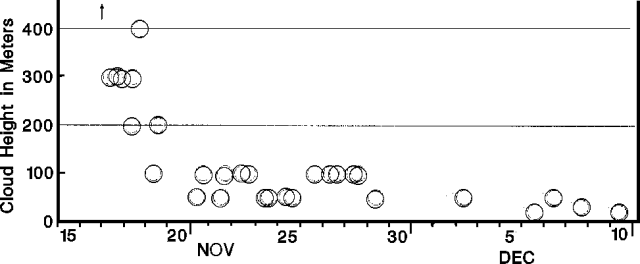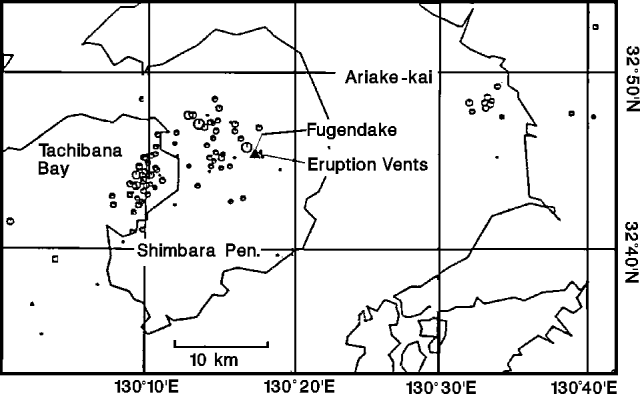Report on Unzendake (Japan) — November 1990
Bulletin of the Global Volcanism Network, vol. 15, no. 11 (November 1990)
Managing Editor: Lindsay McClelland.
Unzendake (Japan) Small gas/ash eruption from two new vents; continued seismicity
Please cite this report as:
Global Volcanism Program, 1990. Report on Unzendake (Japan) (McClelland, L., ed.). Bulletin of the Global Volcanism Network, 15:11. Smithsonian Institution. https://doi.org/10.5479/si.GVP.BGVN199011-282100
Unzendake
Japan
32.761°N, 130.299°E; summit elev. 1483 m
All times are local (unless otherwise noted)
The following supplements the preliminary report of 17 November activity in 15:10.
Ground and aerial surveys [after the eruption began] by JMA and Kyushu Univ revealed that steam plumes were being continuously erupted from two new craters ~650 m E of the summit (Fugen-dake). One was at the E end of Jigoku-ato crater, the other was 100 m S of Jigoku-ato at the E end of Tsukumo-jima crater; the older craters were larger than the new active vents. The steam plumes were about 300-400 m high, occasionally containing ash on 17-18 November; weak ashfall was noted downwind. No explosion sounds were heard and no clear shocks were recorded. The amplitude of continuous tremor gradually declined, and tremor faded away at around 1900. Steam emission from the vent at Jigoku-ato crater stopped on 18 November, but a steam plume continued to rise from the vent at Tsukumo-jima crater through early December, gradually declining to a few tens of meters in height (figure 7). No damage was reported but a ropeway and an area within 2 km of the active vents were closed to tourists on the morning of 17 November.
Earthquakes and tremor episodes had begun in July, with the strongest burst of activity on 25-26 July, and continued at relatively high levels September-November (tables 2 and 3). Seismic activity was almost unchanged before and after the eruption, although seismicity was somewhat stronger in November than during the three previous months. Earthquake swarms occurred at the volcano on 5, 13, 20, and 23 November, contributing to the month's total of 843 recorded events, up from 549 in October and 248 in September. Eighteen shocks were felt in November [at UWS], compared to 15 in October and two in September. The distribution of earthquakes (figure 8) was unchanged from October; most were about 5 km W of the summit at shallow depth. Normal seismicity continued weakly in the Tachibana Bay area about 15 km W of the summit. Few tremor episodes were recorded in the first half of November, but tremor increased in the second half of the month to levels similar to active periods in previous months. Tremor episodes totaled 46 in November, down from 81 in October, while amplitudes were similar to those of previous months. Earthquakes declined in early December, and as of 14 December, no tremor episodes had been recorded since 27 November.
Table 2. Earthquake swarms at Unzen, 1990. Courtesy of JMA.
| Date | Recorded Earthquakes | Felt Earthquakes |
| 07 Jul-08 Jul 1990 | 35 | 2 |
| 24 Jul-25 Jul 1990 | 432 | 26 |
| 09 Aug-11 Aug 1990 | 108 | 3 |
| 17 Oct 1990 | 56 | 0 |
| 23 Oct 1990 | 112 | 8 |
| 31 Oct 1990 | 115 | 2 |
| 05 Nov-06 Nov 1990 | 87 | 0 |
| 13 Nov 1990 | 76 | 4 |
| 20 Nov 1990 | 134 | 11 |
| 23 Nov 1990 | 136 | 1 |
Table 3. Monthly number of earthquakes and tremor episodes at Unzen, 1990. December data are through the 14th. Courtesy of JMA.
| Month | Recorded Earthquakes | Felt Events | Tremor Episodes |
| Jan 1990 | 74 | 0 | 0 |
| Feb 1990 | 53 | 1 | 0 |
| Mar 1990 | 66 | 0 | 0 |
| Apr 1990 | 162 | 1 | 0 |
| May 1990 | 149 | 2 | 0 |
| Jun 1990 | 208 | 1 | 0 |
| Jul 1990 | 922 | 34 | 11 |
| Aug 1990 | 345 | 6 | 56 |
| Sep 1990 | 248 | 2 | 45 |
| Oct 1990 | 549 | 15 | 81 |
| Nov 1990 | 843 | 18 | 46 |
| 01-14 Dec 1990 | 140 | 2 | 0 |
Geological Summary. The massive Unzendake volcanic complex comprises much of the Shimabara Peninsula east of the city of Nagasaki. An E-W graben, 30-40 km long, extends across the peninsula. Three large stratovolcanoes with complex structures, Kinugasa on the north, Fugen-dake at the east-center, and Kusenbu on the south, form topographic highs on the broad peninsula. Fugendake and Mayuyama volcanoes in the east-central portion of the andesitic-to-dacitic volcanic complex have been active during the Holocene. The Mayuyama lava dome complex, located along the eastern coast west of Shimabara City, formed about 4000 years ago and was the source of a devastating 1792 CE debris avalanche and tsunami. Historical eruptive activity has been restricted to the summit and flanks of Fugendake. The latest activity during 1990-95 formed a lava dome at the summit, accompanied by pyroclastic flows that caused fatalities and damaged populated areas near Shimabara City.
Information Contacts: JMA.



